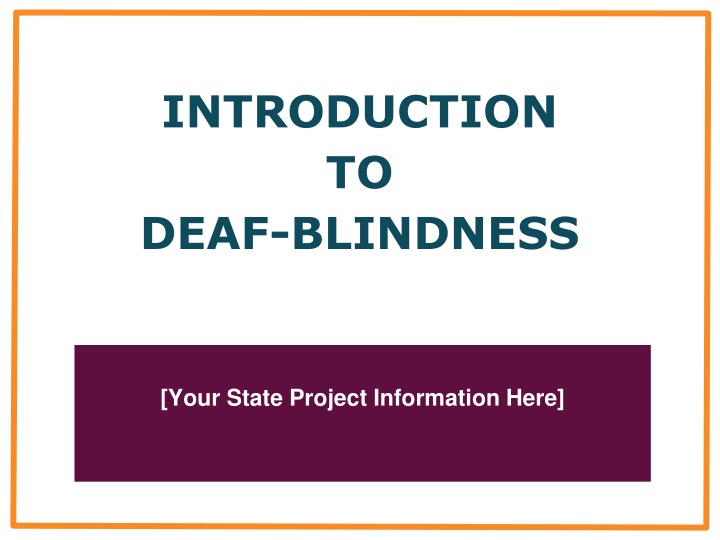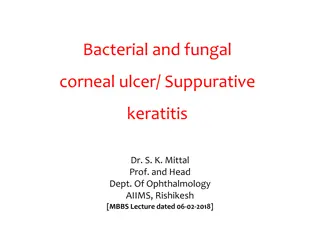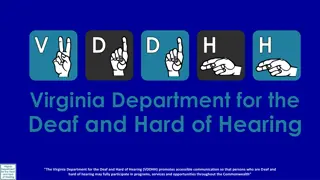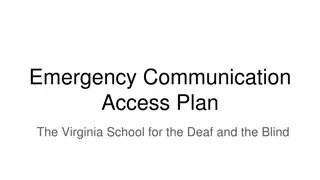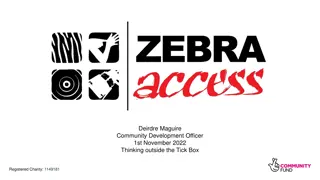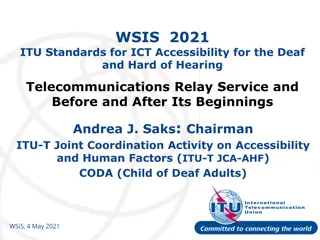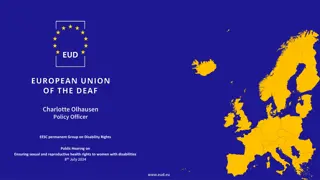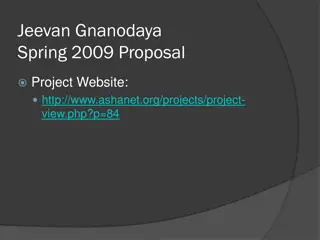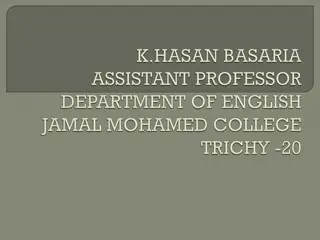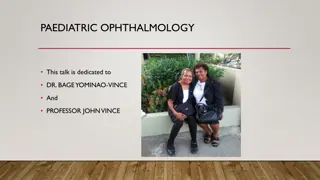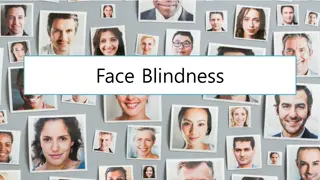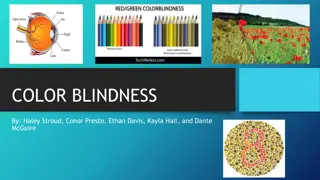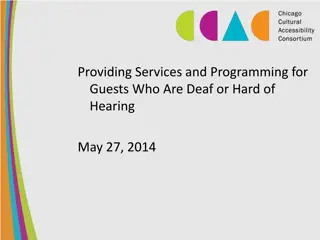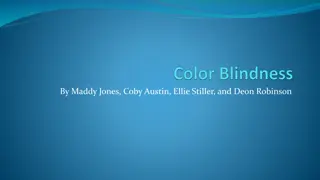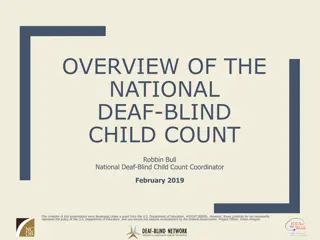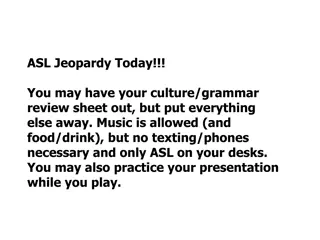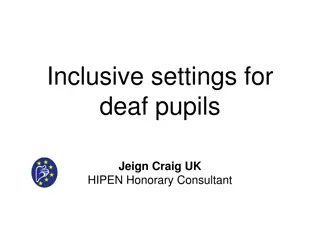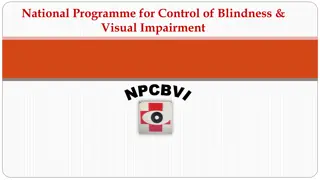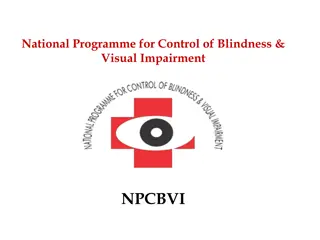Deaf-Blindness: Causes, Impacts, and Support
Deaf-blindness refers to combined hearing and vision loss affecting children's ability to access information. Learn about the causes, impacts, co-occurring disabilities, and resources available for support from state projects and the National Center on Deaf-Blindness.
Download Presentation

Please find below an Image/Link to download the presentation.
The content on the website is provided AS IS for your information and personal use only. It may not be sold, licensed, or shared on other websites without obtaining consent from the author.If you encounter any issues during the download, it is possible that the publisher has removed the file from their server.
You are allowed to download the files provided on this website for personal or commercial use, subject to the condition that they are used lawfully. All files are the property of their respective owners.
The content on the website is provided AS IS for your information and personal use only. It may not be sold, licensed, or shared on other websites without obtaining consent from the author.
E N D
Presentation Transcript
INTRODUCTION TO DEAF-BLINDNESS [Your State Project Information Here]
[Your State Project Name Here] Provides technical assistance and training to statewide agencies, families, community partners, teachers, and service providers of children and young adults with deaf-blindness (birth through 21 years of age) Part of a network that includes state deaf-blind projects across the country and the National Center on Deaf-Blindness
Deaf-Blindness Defined Deaf-blindness refers to combined hearing and vision loss that significantly limits children s ability to get information from people and their surroundings These losses can cause developmental delays in areas such as language, social skills, and mobility, but they do not necessarily limit the individual s learning potential
National Center on Deaf-Blindness (NCDB): Deaf-Blindness Perspectives Open Hands, Open Access modules: http://moodle.nationaldb.org For additional information on national efforts to support students who are deaf-blind, please visit: http://www.nationaldb.org Through collaboration with state deaf-blind projects, families, teachers, interveners and students who are deaf-blind, the National Center on Deaf-Blindness is creating resources that strengthen the educational infrastructure that serves students who are deaf-blind across the nation. Video: Deaf-Blind Perspectives
Major Causes of Deaf-Blindness Hereditary disorders (Usher syndrome, CHARGE syndrome, Down syndrome) Prematurity and birth complications Infections (cytomegalovirus, meningitis, etc.) Injury or stroke
Co-Occurring Disabilities Approximately 90% of children with deaf-blindness have one or more additional disabilities or health problems; 75% have two or more; 50% have three or more For children with complex needs, hearing and vision loss may not yet be recognized or addressed Classifications other than deaf-blindness are often listed as a child s primary diagnosis on the Individualized Family Service Plan (IFSP) or Individualized Education Program (IEP)
Deaf-Blind Child Count Child Count information (without names or identifying information) is submitted to the U.S. Department of Education Assists with funding and planning technical assistance to meet the needs of children Specific state referral information can be included here
Prevalence of Deaf-Blindness Deaf-blindness is an extremely low incidence disability Approximately 10,000 children and youth with deaf- blindness in the U. S. There are approximately [##] children and youth with deaf-blindness in [YOUR STATE]
Incidence of Deaf-Blindness Children with deaf- blindness are often the ONLY one in their school or community with this diagnosis [MAP of your state here]
Early Identification and Referral It is recommended that children with one diagnosed sensory impairment (hearing or vision) be evaluated in the other area Referrals to medical and educational services should be made in a timely manner DO NOT wait and see
Early Intervention The early years are critical, especially in the areas of social-emotional and communication development Early intervention services can help families understand their child s sensory impairment and learn how they can support their child s growth and development
Challenges of Deaf-Blindness Anticipation Motivation Communication Confirmation
Communication & Connection (1 of 2) Communication is . . . Exchanging ideas, thoughts, and feelings The way we connect with people Often challenging for people with deaf-blindness
Communication & Connection (2 of 2) Individuals with deaf-blindness may use a variety of body movements, gestures, vocalizations, pictures, objects, sign language (visual or tactile), speech, augmentative/alternative systems, and other means to communicate.
Assessment & Planning Accurate assessment of communication skills, concept development, and optimal learning modalities is often challenging Standardized instruments are not typically appropriate A team approach, including the family and education professionals, is optimal
Assessment Resources Assessing Communication and Learning in Young Children Who are DeafBlind or Who Have Multiple Disabilities (free, online) The Communication Matrix (free, online) HomeTalk- A Family Assessment of Children who are Deafblind (free, online) Assessment (National Center on Deaf-Blindness)
Deaf-Blind Children Learn Differently Traditional Learners Learn most information incidentally by seeing and listening to what goes on around them Deaf-Blind Learners Incidental learning is difficult or does not occur Hands-on experience and systematic instruction is essential
Learning Needs of Children Who Are Deaf-Blind Hands-on experiences Active movement and exploration of their environment Predictable, accessible schedules, consistency Use of residual hearing and sight High expectations Trusting relationships Communication, communication, communication
Interveners Provide support for social-emotional well-being Provide support for development and use of communication Provide access to sensory information Connect the young learner to the world
Families Family-professional partnerships are essential for promoting optimal outcomes for children with deaf- blindness Parents should be supported in their role as advocates Siblings often experience unique joys and frustrations and may benefit from sibling support programs
State Project Information [Upcoming events] [Contact Information] [Your Project s Website] The contents of this presentation were developed under a grant from the U.S. Department of Education, [enter your project number]. However, those contents do not necessarily represent the policy of the U.S. Department of Education, and you should not assume endorsement by the Federal Government. Project Officer, [enter your project officer]. [Add project logo]
